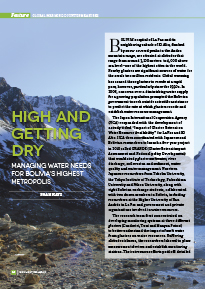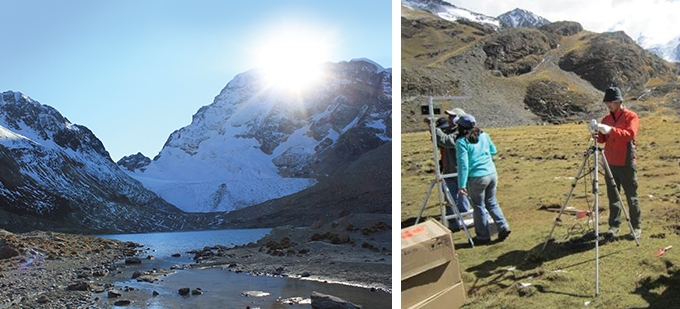Home > Highlighting JAPAN >Highlighting Japan February 2015>Global warming countermeasures
Highlighting JAPAN

Global warming countermeasures
High and Getting Dry
Managing Water Needs for
Bolivia’s Highest Metropolis

Bolivia’s capital of La Paz and its neighboring suburb of El Alto, flanked by snow-covered peaks in the Andes mountain range, are situated at altitudes that range from around 3,100 meters to 4,000 above sea level—one of the highest cities in the world. Nearby glaciers are significant sources of water for the area’s two million residents. Global warming has caused these glaciers to recede at a rapid pace, however, particularly since the 1990s. In 2008, concerns over a diminishing water supply for a growing population prompted the Bolivian government to seek outside scientific assistance to predict the rate at which glaciers recede and establish water resource management.
The Japan International Cooperation Agency (JICA) responded with the development of a study titled “Impact of Glacier Retreat on Water Resource Availability” for La Paz and El Alto. JICA then coordinated with Japanese and Bolivian researchers to launch a five-year project in 2010 called GRANDE (Glacier Retreat impact Assessment and National policy Development) that would study glacier meltwater, river discharge, soil erosion and sediment, water quality and water management. Fourteen Japanese researchers from Tohoku University, the Tokyo Institute of Technology, Fukushima University and Nihon University, along with eight Bolivian exchange students, collaborated with two dozen members in Bolivia, including researchers at the Higher University of San Andrés in La Paz and government and private organizations involved in water resources.
The research team first concentrated on developing monitoring systems at three different glaciers (Condoriri, Tuni and Huayna Potosi) to better understand the impact of melt water from glaciers on water resources. Suffering altitude sickness, the researchers labored to place measurement devices and establish monitoring stations. Their strenuous efforts paid off: detailed data gained by measuring glacier thickness, examining soil erosion, water quality survey and even using 3D laser scanners to measure topography enabled them to create a sophisticated water resource management model.
Besides the effects of high altitude, the researchers had to overcome other difficulties. The March 11, 2011 earthquake and tsunami that struck Japan’s Tohoku region, for example, significantly affected Tohoku University and threatened to disrupt the program.
Nevertheless, “the Japanese researchers there were determined to complete the project,” says Akihiro Miyazaki, director of the Water Resources and Disaster Management Group in JICA’s Global Environment Department. Japanese researchers also had some struggles in communicating with their Spanish-speaking Bolivian counterparts, although the Bolivian exchange students came to their rescue by translating between English or Japanese and Spanish.
Since natural water supplies in the area are not projected to increase, the researchers concluded that Bolivia’s best option was to improve its water resource management. Unification of water supply statistics and the water supply network around El Alto helped to identify areas where drinking water is not distributed from water storage facilities due to decreases in water resources or water leakages, which the Public and Social Company of Water and Sanitation estimates at 30 percent due to leaking pipes.
Since the project term is limited to five years, developing a water resource management platform and transferring technology to the Bolivian side is a high priority for JICA. Nonetheless, Miyazaki is confident that even after the project concludes in 2015, Bolivian researchers can continue with their research, bolstered not only by the monitoring systems and models established but through the Bolivian exchange students’ experience. He adds that with data and know-how, the Bolivian government is better prepared to prevent nonrevenue water use with vital repairs, assess water needs, and consider developing groundwater resources.
Unfortunately, the outlook for the glaciers surrounding El Alto and La Paz remains bleak. Researchers anticipate that they will shrink to 30 or 40 percent of their current size by 2040. But with reliable scientific data, Bolivia is now empowered to tackle the challenges of global warming. Miyazaki believes this will benefit Bolivia overall. “We’re very pleased that, in collaboration between the Higher University of San Andrés and other partners, this project was able to contribute to Bolivia’s development,” he concludes.
© 2009 Cabinet Office, Government of Japan






